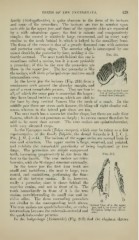Page 419 - My FlipBook
P. 419
TEETH OF THE VERTEBRATA. 429
family (Galeojjithecldce), is quite aberrant in the form of its incisors
and some of the premolars. The incisors are two in number upon
each side in the upper jaw, and those of the opposite sides are separated
by a wide edentulous space ; the first is minute and comparatively
simple ; the second is relatively large, two-rooted, and in every way
similar to the tooth behind it, which is lodged in the maxillary bone.
The form of the crown is that of a greatly flattened cone with anterior
and posterior cutting edges. The anterior edge is interrupted by one
minor denticle, the posterior by four, making it dis-
Fig. 211.
tinctly serrated. The next tooth behind this one is
sometimes called a canine, but it is more probably
a premolar ; if this be the case the premolars are
three in the upper jaw. The last premolar is like
the molars, with three principal cusps and two small
intermediate ones.
In the lower jaw the incisors (Fig. 211) form a
continuous arch around the alveolar margin, and
are of a mo.st remarkable pattern. They are four in
Two Incisors of the Lower
all, of which the outer pair is somewhat the larger Jaw of Galeopil/iecus, ex-
;
ternal view (enlarged).
they have broad incisive crowns, which are cleft to
the base by deep vertical fissures like the teeth of a comb. In the
middle pair there are seven such fissures, dividing off eight slender col-
umns, whereas in the lateral pair there are ten.
The next tooth has a somewhat similar shape, but there are only four
fissures, ^vhich do not penetrate so deeply its cro^vn cannot therefore be
;
said to be more than serrate. The true molars are quintitubercular,
Avitli very elevated cusps.
In the European mole (Talpa europca), which may be taken as a fair
representative of the family Talpidce, the dental formula is I. |^, C. \,
Pm. |-, M. = 44. The incisors of the upper series are normal both in
f
size and structure. The upper canine is large, recurved, and jiointed,
and exhibits the remarkable peculiarity of being implanted by two
fangs. The premolars are simple compressed
teeth, increasing progressively in size from the Fig. 212.
first to the fourth. The true molars are tritu-
bercular, with the W-shaped structure externally.
In the lower jaw the first four teeth are
small and incisiform ; the next is large, two-
rooted, and caniniform, performing the func-
tion of the inferior canine. It is, however,
really a premolar, since it closes behind the
The
superior canine, and not in front of it.
tooth immediately in front of it is the true
canine, notwithstanding its small size and in-
cisive office. The three succeeding premolars
are similar to the corresponding teeth above.
rrii , 1 1 • , 1 1 ,1 Vertical View of a, the upper
ihe true molars are quadritubercular, or rather jaw, and ft, the lower jaw, of
hedge-hog iEnna-
intermediate between the tuberculo-sectorial and ^ZT^""
the quadritubercular patterns.
In the hedge-hogs [Erinacidxje) (Fig. 212) and the elephant shrews


